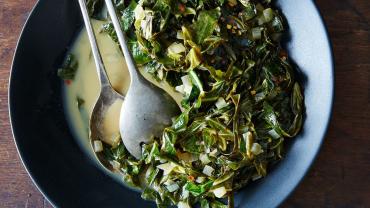
When you think of cruciferous vegetables what comes to mind first? Probably broccoli cabbage and maybe cauliflower and Brussels sprouts. And you can’t walk into a health food store or juice bar without being inundated with marketing material singing the praises of kale. There are kale chips kale smoothies kale everything! But what about kale’s often overlooked cousin collard greens?
For some reason collards just aren’t as popular as kale. You don’t see packages of crispy collard chips with various seasoning blends and nobody’s making raw collard green smoothies. Probably for good reason. The leaves of collards are tough and bitter and the stems are thick and fibrous—even more so than kale’s. But these aspects—which might be considered drawbacks—are actually what make these hardy cold-resistant leaves the perfect subject for their most famous preparation method: cooked down low and slow typically paired with a ham hock a piece of fatback or another piece of salty smoked pork. Once collards cook down they’re as tender as creamed spinach and the bitterness is much reduced. (Not to mention a bit of apple cider vinegar and garlic often help to give them a better flavor.)
So let’s take a look at collards the red—green?—headed stepchild of the cruciferous world. Collard greens are actually the same species as broccoli kale cabbage and Brussels sprouts—Brassica oleracea. Collards are part of the Acephala group of this species—Acephala Greek for “without a head” meaning collards (as well as all forms of kale) do not form tight heads the way cabbage does.
Like their cruciferous brethren collards are loaded with nutrients. They’re high in folate vitamin K vitamin C vitamin A precursors calcium and manganese. They’re high in fiber too—a 100-gram serving has only 2 grams net carbs (6g total minus 4g fiber) making these great for low-carb and ketogenic diets. (Not to mention Paleo vegetarian vegan and low-fat.) Cooked collards are slightly less nutrient-dense than raw but raw collards are pretty unappetizing and difficult to eat. (Have fun chewing; see you in about a week!) The small nutrient losses during cooking are mostly due to nutrients leaching out into the cooking water when they’re boiled. This is a non-issue if the cooking water is consumed such as in a soup or long slow braised collards. (In the South the liquid from traditionally prepared collards is known as “pot liquor” (or even pot likker) and it’s enjoyed with gusto.)
Collards also share other nutritional properties with their cruciferous relatives. They’re high in sulfur and their metabolites include indol-3-carbinol and di-indolylmethane which may be helpful for reducing excess estrogen. The leaves are higher in glucosinolates than the stems but unless you have a compost pile there’s no reason to discard the stems. Cooked properly they become as tender and delicious as the leaves.
Another feather in collards’ cap is reducing cholesterol by binding to bile acids. (If high cholesterol even needs to be a concern anymore—and much research indicates it doesn’t.) Cooked (steamed) collards have greater bile acid binding capability than raw (at least in vitro) which is another reason to make sure to eat these cooked in case getting a jaw workout by chomping on raw collards wasn’t deterrent enough.
So collards have a lot going for them. Are there any reasons to avoid them? Well maybe but again only if you’re in the habit of eating large amounts of them raw. Like the other cruciferous vegetables collards contain goitrogens and high consumption of these foods raw might depress thyroid function by inhibiting iodine absorption. (As nutritious as these foods are that doesn’t mean we can consume large amounts raw with impunity. There are reports of people overdoing it on raw greens in smoothies and unintentionally inducing thyroid dysfunction.) But this isn’t a reason to avoid collards and other crucifers. Their beneficial compounds outweigh the small potential for adverse effects on the thyroid gland. Small amounts of raw cruciferous vegetables are okay; no one’s going to jeopardize their thyroid health if they enjoy coleslaw now and then. People should simply be reasonable about it.
So how to get collards into the diet? There’s of course the classic preparation of collards cooked low and slow with the smokiness and saltiness of a ham hock. And the pork fat does more than just lend flavor: remember carotenoids are absorbed better when consumed with fat. (The Italians were on to something ages ago when they decided to put olive oil on their tomato dishes. It’s the same reason it’s best to add some fat to a salad in order to get the benefits of consuming tomatoes carrots and other carotenoid-rich vegetables.
Other kinds of savory pork can spruce up collards such as in this recipe for bacon-braised collard greens. They can even be used for something a bit more exotic like coconut curry collard greens. Collards are pretty bitter but one way to take the edge off is to combine them with something sweet such as the apples in sautéed collard greens and apples. And even though large amounts of raw collards should be avoided a little bit here and there is fine. For those looking to try them this way consider this colorful and refreshing sweet and tangy collard green slaw.